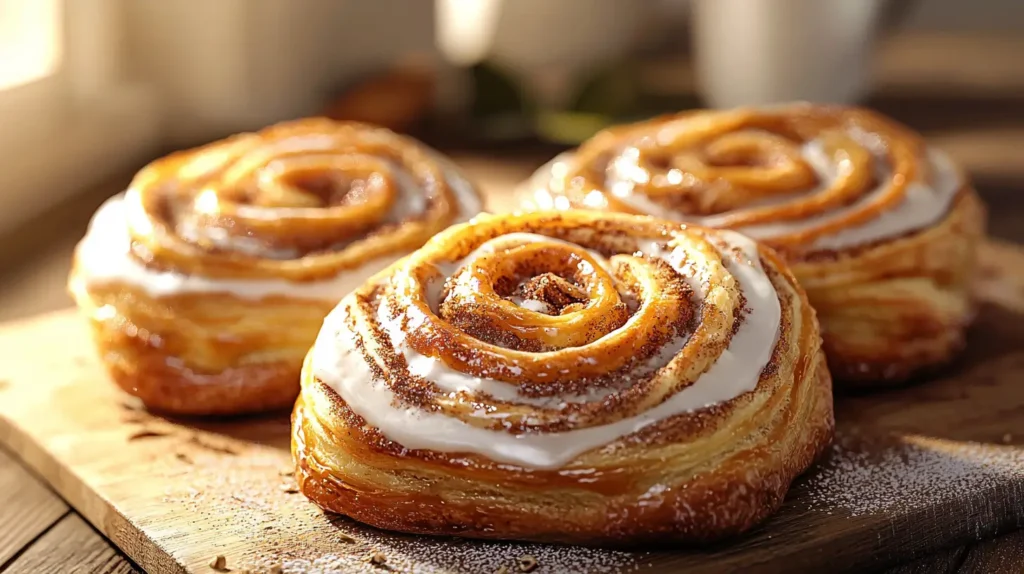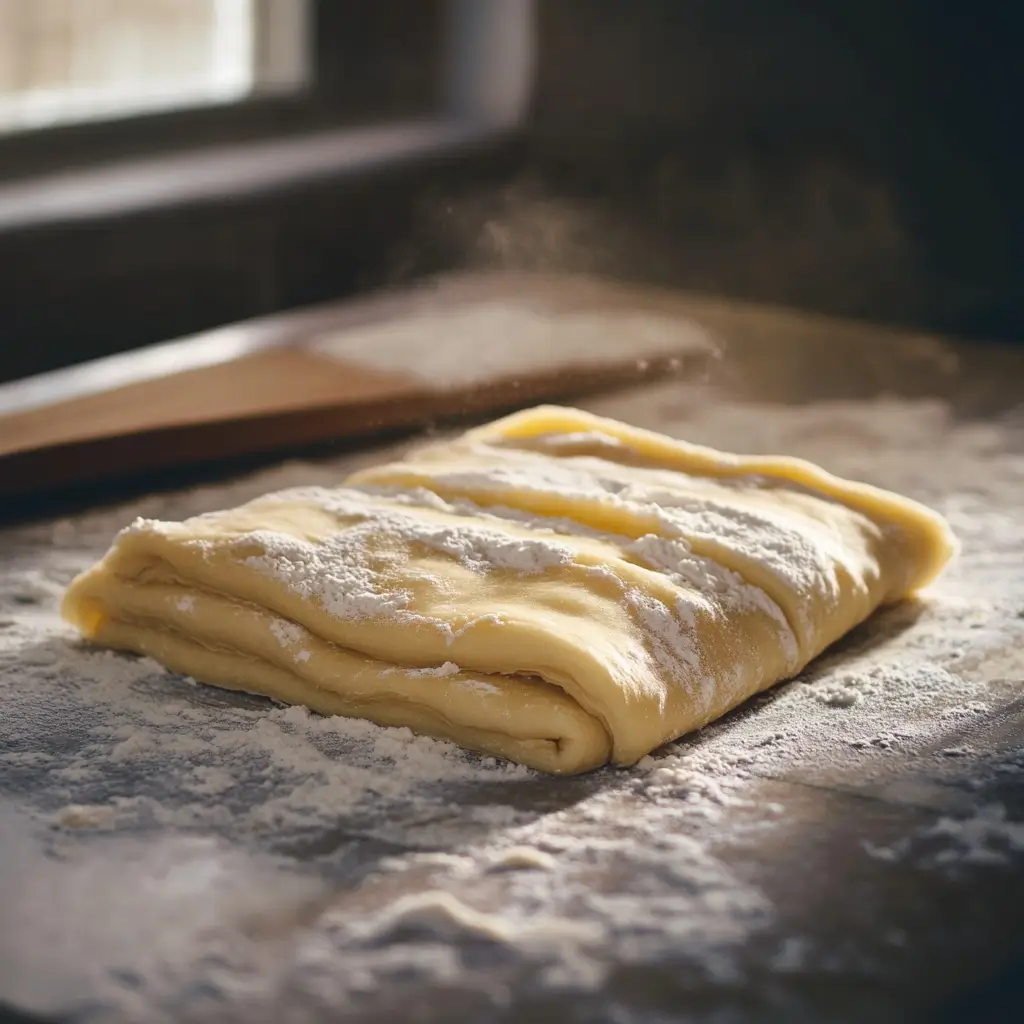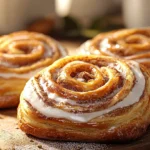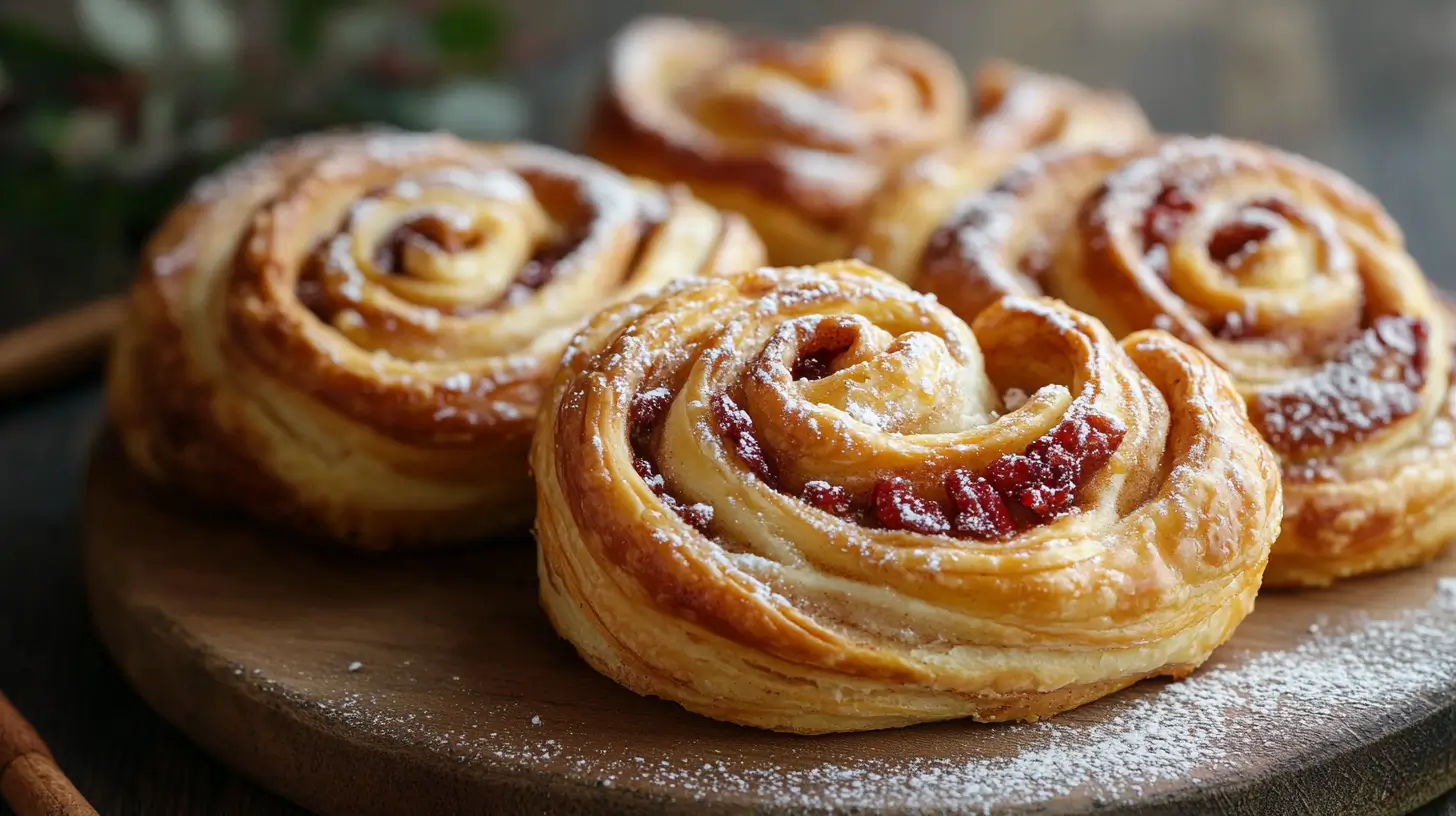Cinnamon Danish brings back memories with every bite. Imagine walking into a bright bakery, the warm scent of butter and cinnamon filling the air. That first taste feels like a cozy weekend morning, a comforting afternoon, or a sweet midweek treat.
This danish pastry has become a favorite in American bakery treats. It mixes heritage with delicious flavor in every flaky bite.
Whether with coffee or enjoyed alone, the cinnamon danish is loved by all. Its roots are in Austria, but it’s found a new home in American bakeries. Today, it’s a symbol of joy, with modern twists like vegan versions or nutmeg accents keeping it fresh.
Key Takeaways
- Originating from Austria, now a beloved cinnamon danish tradition in Denmark and North America.
- Signature ingredients: butter, cinnamon, and flaky layers, often with cream cheese or custard fillings.
- 255 kcal per serving, customizable with spices like vanilla or nutmeg.
- Popularized in the U.S. by bakeries like Ole & Steen, offering vegan and gluten-free options.
- Perfect with coffee, tea, or milk, symbolizing comfort and shared moments.
What Makes a Cinnamon Danish So Irresistible?
Imagine biting into a sweet breakfast pastry that awakens your senses. The cinnamon danish offers a journey of flavors. It’s hard to resist for good reasons.

The Perfect Balance of Sweet and Spicy
The mix of cinnamon swirl and sugar is perfect. Unlike too sweet treats, danishes balance sweetness with cinnamon. This balance makes each bite irresistible. Try it with Saigon cinnamon for a stronger flavor.
The Flaky, Buttery Texture
High-quality butter makes it crunchy. Laminated dough creates hundreds of airy pockets. This gives the pastry a unique pastries with cinnamon texture.
The result is crispy edges and tender interiors. All thanks to butter’s rich flavor.
The Aroma That Draws You In
Cinnamon’s scent can trigger cravings. Bakers use it to fill bakeries with inviting smells. Saigon cinnamon’s bold aroma makes every sweet breakfast pastry irresistible.
From the first whiff to the last flake, every part of a cinnamon danish is made to delight. Its appeal comes from science and tradition.
The Rich History of Danish Pastry
Did you know the danish pastry you enjoy today has roots stretching across continents? It all started in 19th-century Austria. A strike in Denmark’s bakers’ guild led to adopting Vienna’s laminated dough techniques. Danish bakers mixed these methods with local flavors, creating what became known as wienerbrød.
This name was too tricky to say, so “Danish” stuck. This is how the danish pastry got its name.
- 1850: Austrian baking techniques merge with Danish traditions.
- 1900s: Danish immigrants, like Anton Olesen, brought recipes to Racine, Wisconsin, a city where 13.7% of residents were Danish by 1920.
- 1949: O&H Danish Bakeries opens, preserving traditional methods while adapting to American tastes.
- 2013: Wisconsin declares kringle its official state pastry, honoring its Danish-American heritage.
These delightful pastries evolved as Danish settlers blended European traditions with American preferences. The cinnamon danish emerged as a star, balancing flaky layers with sweet fillings. From Racine’s bakeries to modern recipes using Medjool dates and cardamom, every bite tells a story of migration and cultural exchange.
This legacy lives on in bakeries like O&H, where danish pastry techniques endure since 1949. Next, we’ll explore how these pastries are crafted layer by layer.
Anatomy of the Perfect Cinnamon Danish
Every bite of cinnamon pastry is a mix of texture and flavor. Let’s look at the three key parts that make a cinnamon danish stand out.

The Laminated Dough Base
Layers are the secret to flaky pastry. Here’s how it works:
- Cold butter sheets folded into dough create hundreds of layers
- Rest periods (2 hours minimum) let gluten relax for tenderness
- 4-5 turns of dough and butter achieve signature lightness
The Cinnamon Filling
Flavor starts with a sweet-spice blend:
- 2 tablespoons cinnamon mixed with 1 1/4 cups brown sugar
- Melted butter binds ingredients into a sticky mixture
- Optional: chopped walnuts or pecans add texture
The Glaze or Icing
Finishing touches make it special:
| Option | Ingredients | Texture |
|---|---|---|
| Cream cheese glaze | Cream cheese, butter, powdered sugar | Rich and tangy |
| Classic glaze | Powdered sugar, milk, vanilla | Crystalline and sweet |
Each layer needs precision. From the buttery dough to the final glaze, these parts come together. They make the delicious baked goods Americans adore.
How Cinnamon Danish Differs From Other Sweet Breakfast Pastries
The cinnamon danish is special among sweet breakfast pastries. It has flaky layers and a cinnamon heart. This makes it stand out from others.
Cinnamon Rolls vs. Cinnamon Danish
Cinnamon rolls and cinnamon danish both use cinnamon. But they start with different doughs. Cinnamon rolls use soft bread dough, while cinnamon pastry uses laminated dough.
This laminated dough makes the danish pastry’s flaky texture. Cinnamon rolls have a spiral design, while danishes have open centers filled with cinnamon and sugar.
Danish Pastry vs. Croissants
| Feature | Croissant | Danish Pastry |
|---|---|---|
| Flavor | Savory | Sweet |
| Layers | Butter folds only | Includes egg for richer dough |
| Filling | Rarely filled | Cinnamon, fruit, or custard |
Croissants are buttery and plain. Danish pastry is sweeter, with fillings like cream cheese or jam.
American Adaptations of the Classic Danish
- Portion size: Bigger than European versions
- Sweeter toppings: Cream cheese glaze vs. traditional icing
- Creative fillings: Caramel, chocolate, or even Nutella variations
These changes make the sweet breakfast pastry a favorite in America. They honor its origins while adding new twists.
Making Your Own Cinnamon Danish at Home
Baking a cinnamon danish at home takes patience but yields amazing results. It takes 8–10 hours, including rest times, to get layers as flaky as your favorite delicious baked goods. Begin by mastering the dough’s lamination. This means folding dough and butter together to create those signature layers.
- Use a food processor for smooth dough mixing.
- Chill dough between folds to keep butter solid.
- Brush egg wash for a golden finish.
Having the right tools like a rolling pin and parchment paper helps with shaping. Cold butter and steady temperatures are key to avoid dough tears. Be careful not to overfill or rush the shaping to prevent cracks. Layer the cinnamon-sugar slowly.
Freezing dough after shaping is a great option for busy days. This way, you can bake it later.
Look for a golden crust and a firm center to know your cinnamon danish is done. Place oven racks in the middle and rotate pans halfway through baking. Let pastries rest for 10 minutes before glazing for a professional finish.
Though it takes time, baking at home rivals bakery treats with its homemade freshness. It’s perfect for weekend projects, turning your kitchen into a mini-pastry shop. Next, learn the exact ingredients to improve your skills.
Essential Ingredients for an Authentic Cinnamon Danish

Making the perfect cinnamon pastry begins with the best ingredients. Each part, from butter to spices, is crucial for that flaky texture and warm flavor. Let’s explore what you need to make this classic treat.
Quality Butter for Flaky Layers
Use European-style butter with at least 82% fat, like Plugrá, for crisp layers. Cold butter chunks folded into the dough make flaky pockets. Choose unsalted butter to control the flavor. Professional bakers keep dough cold to prevent butter from melting.
Selecting the Right Cinnamon
Saigon cinnamon is perfect for cinnamon swirl fillings, offering bold, sweet heat. Avoid generic cinnamon and try Ceylon for a subtle warmth or Cassia for a strong spice. Buy small amounts and store them in airtight containers. A 1.5 tbsp-to-6 tbsp sugar ratio balances sweetness and spice.
Optional Add-Ins for Extra Depth
- Cream cheese: 4 oz folded into icing adds tangy contrast
- Nuts: Toasted walnuts or pecans for texture
- Vanilla: Pure extract enhances cinnamon notes
- Cardamom: 1 tsp pairs perfectly with traditional danish pastry dough
Try 1-2 add-ins to keep the flavors balanced. For a twist, add citrus zest or a pinch of salted caramel.
Popular Cinnamon Danish Variations Across America
From coast to coast, cinnamon danish recipes reflect local tastes. In Wisconsin, O&H Danish Bakery is famous for kringles. These are braided pastries filled with cream cheese and walnuts. On the West Coast, delightful pastries often include mango or berry mix-ins.
Imagine a California cinnamon danish with lemon zest and blueberries. Or a New England version with maple-glazed bacon. These are just a few examples of the amazing flavors you can find.
Every region in America adds its own twist to cinnamon danish. Southern bakeries might use apple cinnamon or pecan praline fillings. Meanwhile, Pacific Northwest cafes might try almond custard or pumpkin spice.
The basic recipe is simple: 2 cups flour, 1 cup cold butter, and sour cream. But bakers love to get creative. Some add 8 ounces of cream cheese to the filling. Others swap cinnamon for cardamom, paying homage to Scandinavian traditions.
- West Coast: Berry medley or peach preserves
- Midwest: Cream cheese & walnut kringles
- South: Apple cinnamon or pecan praline
- West Coast: Tropical mango or lemon blueberry
Whether you like pastries with cinnamon or savory spinach-feta, there’s something for everyone. The cinnamon danish is more than a breakfast treat. It’s a journey of flavors. Next time you’re in the mood for something sweet, try these regional twists. You’ll see how a simple dough can become America’s favorite delightful pastries.
Pairing Your Cinnamon Danish with the Perfect Beverage
Choose the perfect drink to go with your cinnamon danish. Each sip should bring out the pastry’s flavors, from the buttery dough to the cinnamon filling. Find drinks that complement or enhance the pastry’s spices.
Classic Coffee Pairings
Coffee and cinnamon go well together. Light roasts let the pastry’s warmth stand out. Creamy lattes add a rich touch. Here’s how to pair them:
- Light Roast Coffee: Highlights cinnamon’s brightness
- Espresso: Intense flavor cuts through buttery layers
- Cinnamon Lattes: Add a sprinkle of cinnamon to your drink for cohesion
Tea Options That Complement Cinnamon
Tea can make your treat even better. Chai’s cinnamon and black tea base is a perfect match. Rooibos with cinnamon sticks is a great caffeine-free choice. Try these:
- Spiced Chai: Matches the pastry’s spice blend
- Rooibos with cinnamon: Warmth without caffeine
- Earl Grey: Bergamot adds citrus contrast to bakery treats
Unexpected Drink Pairings to Try
Try these creative pairings to surprise your taste buds. Sparkling water with a cinnamon stick is refreshing. Apple cider’s sweetness matches the pastry’s spices. For evening, consider:
- Gløgg: A Scandinavian mulled wine with cloves and cinnamon
- Spiced Rum Punch: Cinnamon sticks as garnish in cocktails
- Cinnamon-infused cocktails: Syrups or bitters add complexity to drinks
Drinks aren’t just a guess. Coffee’s acidity, tea’s aroma, or a cocktail’s spice can make your cinnamon danish unforgettable. Try these ideas to find your perfect match for any sweet pastry.
Where to Find the Best Cinnamon Danish in Your City
Finding the best cinnamon danish means knowing what to look for. A great delicious baked goods has the right mix of spice and sweetness. It should have flaky layers and a shiny glaze. These signs help you find the best bakery treats in your area.
A great cinnamon danish needs no extra sugar—it shines through technique and ingredients.
What to Look for in a Quality Bakery
- Layers: Check for visible flaky layers in the dough.
- Ingredients: Fresh cinnamon and real butter make a difference.
- Timing: Ask when pastries are baked—fresh batches taste better.
Hidden Gems Across America
Don’t just look at big chains. Places like Cinnaholic or Copenhagen Pastry are often hidden gems. Family-run shops in cities like Los Angeles (Sweet Jill’s) or Santa Monica (Tartine) offer unique versions. Even hotel breakfast bars, like those at The Lodge Bread Company, sometimes serve amazing cinnamon danish.
Next time you want a cinnamon danish, check out bakeries that focus on tradition and freshness. The best bakery treats share a story with every bite.
The Nutritional Profile of a Cinnamon Danish
A cinnamon danish is a mix of indulgence and nutrition. It’s a treat and a mindful choice. Let’s explore what makes it special.
A standard cinnamon danish has 250–300 calories. It has 14–15g of fat, with 8–9g of saturated fat. Carbohydrates are 27–37g, and protein is 3–6g.
It has less fiber, but it does offer some iron and calcium from dairy.
- Calories: 250–300 per serving
- Fat: 14–15g (with 8–9g saturated)
- Sugar: 9–24g, depending on glaze or fillings
- Key minerals: 3–5% daily calcium and iron
A cinnamon danish isn’t just calories—it’s a balance of flavors worth savoring occasionally.
Enjoy it as an occasional treat. Opt for smaller portions or ask for less sugar. Swapping part of the pastry with whole-grain dough or reducing glaze can cut carbs and sugars. Pair it with a protein-rich drink like almond milk to balance the meal.
Nutritionally, it’s best enjoyed mindfully. By making small adjustments, you can keep enjoying this classic sweet breakfast pastry without compromising your goals.
Conclusion: Why the Cinnamon Danish Remains a Beloved Bakery Classic
The cinnamon danish is loved for its history, skill, and indulgence. It has roots in ancient cinnamon trade and Sweden’s 1920s innovation. Each bite offers a mix of flaky layers, sweet spices, and glossy glazes.
What keeps these pastries popular? Their ability to change yet stay true. From New York’s kanelbullar to California’s gluten-free versions, they adapt. They pair well with coffee or modern drinks like matcha lattes.
Today’s bakers keep the danish’s spirit alive while meeting new tastes. They use vegan cream cheese or almond flour. Yet, the essence remains: flaky layers, cinnamon warmth, and the joy it brings.
For you, the cinnamon danish is more than breakfast. It connects you to a shared culinary history. Its journey from Swedish bakeries to American diners shows the power of simple ingredients. Enjoy it as a heritage treat and a canvas for creativity. The cinnamon danish’s story is ongoing, one flaky layer at a time.
FAQs
What is a cinnamon danish?
A cinnamon danish is a sweet breakfast treat. It’s made from dough with layers of butter for a flaky texture. The filling is cinnamon and sugar, topped with icing or glaze.
How is a cinnamon danish different from a cinnamon roll?
Cinnamon danish uses laminated pastry dough, unlike cinnamon rolls which use yeasted bread dough. This makes danish pastries flaky and crisp. They also have richer fillings and sweeter glazes.
What are the typical flavors in a cinnamon danish?
The flavor of a cinnamon danish comes from brown sugar and cinnamon. This mix is sweet and spicy. Some danishes may also have cream cheese, nuts, or fruit for extra flavor.
Can I make a cinnamon danish at home?
Yes, making cinnamon danish at home is possible. It takes time due to the laminated dough process. You’ll need the right tools and know-how for great results.
What ingredients are essential for an authentic cinnamon danish?
For an authentic cinnamon danish, you need high-quality butter, fresh cinnamon, and sugar. Adding cream cheese or nuts can make it even better.
Are there any regional variations of cinnamon danish in America?
Yes, there are many regional variations. The Midwest loves cream cheese in their danishes, while the West Coast adds fruit. This shows how versatile danish pastries can be.
What beverages pair well with a cinnamon danish?
Classic coffee pairs well, especially light roasts. Tea, like chai or rooibos, also complements the flavors. For something different, try sparkling drinks or dessert wines.
How can I identify a quality bakery that sells cinnamon danish?
Look for even lamination, right size, and a good glaze. A bakery with a nice aroma and friendly staff is a good sign. Ask about their baking practices for the best experience.
What is the nutritional content of a cinnamon danish?
A cinnamon danish has refined carbs and sugars. It may also have some benefits from dairy and cinnamon. Enjoy it in moderation as part of a balanced diet.
Table of Contents

Cinnamon Danish
- Total Time: 2 hours 48 minutes
- Yield: 12 danishes 1x
Description
This Cinnamon Danish is the perfect blend of buttery, flaky pastry and sweet cinnamon filling. The rich layers of laminated dough create a light, crisp texture, while the warm cinnamon-sugar swirl and glossy glaze make each bite irresistible. Perfect with coffee or tea, this homemade treat brings bakery-quality flavor straight to your kitchen.
Ingredients
For the Dough:
2 ¼ teaspoons (1 packet) active dry yeast
¼ cup warm water (110°F/45°C)
½ cup whole milk, warmed
¼ cup granulated sugar
1 large egg, room temperature
½ teaspoon salt
2 ¾ cups all-purpose flour
1 cup (2 sticks) cold unsalted butter, cut into thin slices
For the Cinnamon Filling:
⅔ cup brown sugar, packed
2 tablespoons ground cinnamon (Saigon or Ceylon preferred)
¼ cup unsalted butter, melted
For the Glaze:
1 cup powdered sugar
2 tablespoons milk
½ teaspoon vanilla extract
Instructions
Prepare the Dough:
In a small bowl, dissolve the yeast in warm water. Let sit for 5–10 minutes until foamy.
In a large mixing bowl, combine warm milk, sugar, egg, and salt. Stir in the yeast mixture.
Gradually add the flour, mixing until a soft dough forms.
Lamination:
Roll out the dough on a floured surface into a rectangle (about 12×18 inches).
Layer the butter slices over two-thirds of the dough. Fold the uncovered third over the buttered section, then fold the opposite end over.
Roll out the dough, fold it into thirds again, and chill for 30 minutes. Repeat this process 4 times to create flaky layers.
Make the Filling:
Mix brown sugar and cinnamon in a small bowl. Stir in melted butter until combined.
Shape the Danishes:
Roll out the chilled dough into a large rectangle. Spread the cinnamon filling evenly over the dough.
Roll the dough into a log and slice it into 1-inch pieces. Place them on a baking sheet lined with parchment paper.
Let rise for 45 minutes until puffy.
Bake:
Preheat oven to 375°F (190°C).
Bake for 15–18 minutes, or until golden brown.
Make the Glaze:
Whisk together powdered sugar, milk, and vanilla until smooth.
Drizzle over warm danishes before serving.
Notes
For extra depth, add a pinch of nutmeg or cardamom to the filling.
If you prefer a richer glaze, substitute milk with cream.
Store leftovers in an airtight container at room temperature for up to 2 days or freeze for up to 1 month.
For a savory twist, try filling the dough with cream cheese and ham.
- Prep Time: 30 minutes (plus 2 hours resting time)
- Cook Time: 18 minutes
- Category: Breakfat, Dessert
- Cuisine: Danish-American
Nutrition
- Calories: 255 kcal
- Fat: 14 g
- Carbohydrates: 27 g
- Protein: 4 g

